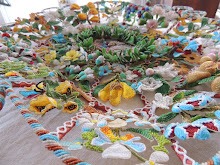Collecting....Responsibly (part 1 of 2)
Not all people are gatherers....but for those of us who are, and who feel a strong connection to, and are driven to collect bits and pieces of our Historical past, I would like to share my thoughts on the "Responsibilities" that should go hand in hand with doing so. I have been rather surprised lately on just how many collectors have never given any real thought to the proper care and storage of their collected artifacts....not really out of any malice or disrespect, but just that it had never really crossed their mind, or they don't know who to ask about it.
There are different rules and guidelines for different objects, but I am focusing on textiles. Most everyone has some family heirloom in a textile form that they would like to know how to properly take care of, so that whatever it is, will last for future generations.
I am not going to get into 'Professional' grade storage and conservation, as it is ridiculously expensive, and I'm sure most everyday folks will not want to turn their house into a sterile Industrial environment. The key to responsible collecting is to be able to enjoy our treasures, but at the same time keep them safe from certain environmental factors that we do have easy control over.
Antique textiles are the most difficult of all objects to store and conserve, as they are organic, living, breathing things. Most people have heard the common "myth" that their family heirloom clothing and linens should be carefully packed in a cedar chest.....when in fact, this is about the worst thing you could do. Any wood storage container will create a micro environment(as will plastic), and since wood gives off tannic acid, not to mention attracting bugs, storing your textiles in a wooden chest of any type will age and discolor and weaken them faster than if you left them out on a shelf. Cedar does repel insects, but it still gives off acids, and should not be used to store early textiles. Textiles are very fragile in the way that too much humidity and they can mold, if they get wet they can water stain...metal fasteners and buttons can rust, celluloid based trims will dissolve. Too dry, too hot, and they can become brittle and can turn to dust. The thing to remember, is to keep whatever space they are in clean, dry, and at a constant temperature. Do NOT store things in the attic, or basement, or where the temp fluctuates from hot to cold extremes.
Things to avoid around your textiles, both in storage, and on display are....
****FOOD! Crumbs, little dropped bits, oils and smells are just a hint of what is left behind from foodstuffs. Besides the horror of actually spilling food or a beverage on an antique textile that cannot be cleaned, it attracts bugs, and little verminous creatures like mice. It is best to not allow ANY food or drinks in your storage area or displays.
Along the food line, you don't want to display your textiles near a kitchen, or place where food is prepared. Even if you use a hood over your cook top, there will still be particles of grease in the air, that can penetrate your textiles and absolutely ruin them.
*****BUGS!! Ohhh these critters are the worst! Flies don't munch on textiles, but they do leave their droppings, known as 'fly spec', that look like little brown dots. Carpet beetles and silverfish will eat textiles, and their shed skins as they are growing also attract other bugs, and before you know it, you will have an all out infestation....not to mention microscopic eggs from the little buggers multiplying faster than rabbits.....
You don't need to go rushing out to buy a bunch of chemicals, and unless you do have an infestation problem, I don't recommend buying insect traps either~ the pheromones the traps are baited with can actually attract insects. The easiest things to do, is to be clean. Clean Clean Clean, and clutter free. Inspect your storage area and displays often. Vacuum often. A clean area, is a safe area for your textiles.
******SMOKE! I clump nearly all airborne particles into the smoke category. Grease and food particles can be in the air from cooking dinner, carcinogens from a fireplace or an actual person smoking....if you can smell it, it can penetrate the natural fibers of a textile, and cause irreversible damage. Keep your air clean...and that goes for aerosol cans of bug killers, hairsprays, room scents~ all these are chemicals that can alter/stain/destroy fabrics! Keep your air clean.
****LIGHT! Most people know by now, direct sunlight can reduce a textile to dust....and if you didn't know~ it can! ultra Violet (UV) radiation breaks down natural fibers~ we see it first as fading of colors...but it also causes the fibers to become brittle and break. So keep your storage area DARK, and make sure your displays are not in front of a window. Do not use the daytime or UV bulbs in your lamps, and keep spotlights to a minimum~ you can get JUST AS MUCH UV light from sources inside the house, as you can from the sun
*****WATER! Water has NO place around antique textiles. none none none! Do not store, or display things, next to say, a sink, or a water pipe, or next to the water heater...be aware of the sources of water in your home, and keep your textiles away from it, then you wont have to worry about a pipe breaking and soaking everything. Dyes and colors of early textiles are not always colorfast, and you could really be in for heartbreak if things get wet. Water can cause irreversible damage
****PETS. Now I love animals~ we live on a farm~ but they have no place around my textiles, and are not allowed anywhere near the gallery. Disaster is easily avoided but keeping pets away from your displays and storage areas.
In part 2, I will touch on some easy things you can do to protect and prolong the life of your collections
Monday, September 27, 2010
Subscribe to:
Post Comments (Atom)






















No comments:
Post a Comment